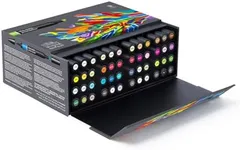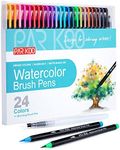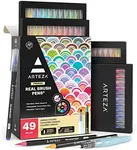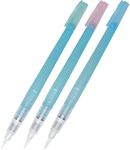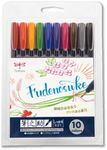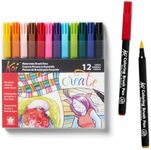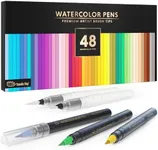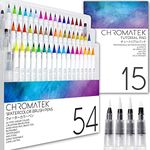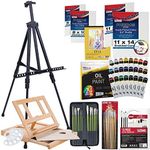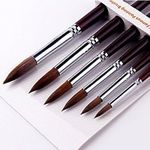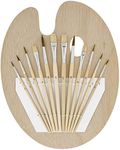Buying Guide for the Best Watercolor Pens
Choosing the right watercolor pens can significantly enhance your artistic experience, whether you're a beginner or a seasoned artist. Watercolor pens combine the convenience of markers with the fluidity of watercolors, making them a versatile tool for various art projects. To find the best fit for you, it's essential to understand the key specifications and how they align with your artistic needs and preferences.Brush TipThe brush tip of a watercolor pen mimics the feel of a traditional paintbrush, allowing for a range of strokes from fine lines to broad washes. This spec is important because it determines the versatility and control you have over your artwork. Brush tips can vary in flexibility; some are firmer, providing more control for detailed work, while others are softer, allowing for more fluid and expressive strokes. If you prefer detailed illustrations, opt for a firmer brush tip. For more expressive and loose styles, a softer brush tip might be more suitable.
Ink QualityInk quality in watercolor pens affects the vibrancy, blendability, and permanence of your artwork. High-quality inks are typically more vibrant and blend smoothly, creating beautiful gradients and washes. They are also more likely to be lightfast, meaning they won't fade over time. If you are creating artwork that you want to last, look for pens with archival-quality, lightfast ink. For practice or casual use, standard ink quality may suffice.
Color RangeThe color range refers to the variety of colors available in a set of watercolor pens. This is important because a broader color range allows for more creative freedom and the ability to create more complex and nuanced artwork. Sets can range from a few basic colors to extensive collections with dozens of shades. If you're just starting, a smaller set with primary and secondary colors might be enough. For more advanced artists or specific projects, a larger set with a wide range of hues and tones can be beneficial.
Water SolubilityWater solubility indicates how well the ink in the pens can be activated and blended with water. This is crucial for achieving the watercolor effect, as it allows you to create smooth transitions and washes. Some pens are more water-soluble than others, making them easier to blend. If you want to achieve traditional watercolor effects, look for pens with high water solubility. For more controlled and less fluid effects, pens with lower water solubility might be preferable.
Ease of UseEase of use encompasses how comfortable and intuitive the pens are to handle. This includes the grip, the flow of the ink, and how easy it is to control the brush tip. Pens that are easy to use can make the creative process more enjoyable and less frustrating, especially for beginners. If you're new to watercolor pens, look for ones with ergonomic designs and consistent ink flow. More experienced artists might prioritize other features, but ease of use is always a valuable consideration.
